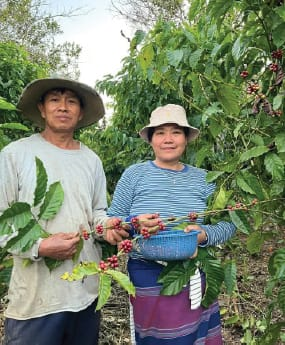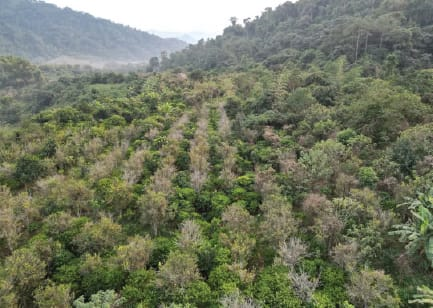KPL
Coffee, one of the world’s most popular beverages, is not only a daily staple for millions but also a lucrative cash crop. Its high market value and consistent demand both domestically and internationally have made coffee farming an attractive venture for many across Laos.

(KPL) Coffee, one of the world’s most popular beverages, is not only a daily staple for millions but also a lucrative cash crop. Its high market value and consistent demand both domestically and internationally have made coffee farming an attractive venture for many across Laos.
One such success story is that of Mr. Khampao Phanphongsi, a 54-year-old coffee grower who has turned a modest farm into a thriving business, generating an annual income of around 50 million kip.
Mr. Khampao began his agricultural journey in 1994 after marrying Ms. Chan Sumunthong, a government employee. Together, they raised two children. Initially, the family spent their spare time growing small cardamom, but the short harvest cycle and plant lifespan made it an unsustainable option.
In 2019, seeking a more stable crop, Mr. Khampao transitioned to coffee farming, intercropping the plants with fruit trees for shade. He started with just one hectare of land and 1,100 coffee plants.
By 2023, the farm yielded its first significant harvest—one ton of red coffee cherries, which produced 400 kg of dried beans and 200 kg of roasted coffee. Sold at 40,000 kip per kilogram, the beans brought in around 8 million kip in revenue.

A year later, production had quadrupled. In 2024, the farm produced 4 tons of red cherries, yielding 1,600 kg of dried beans and 800 kg of roasted coffee, which sold for 50,000 kip per kilogram—earning the family 40 million kip. Additional income from fruit trees and garden produce brought the total yearly earnings to about 50 million kip.
Beyond selling roasted beans, Mr. Khampao has also ventured into value-added products such as coffee soap and coffee flower tea, further diversifying his income sources.
Encouraged by the success, Mr. Khampao expanded his coffee plantation to 8 hectares, now home to 8,800 coffee plants. Currently, 1.5 hectares are actively producing, with the remaining 6.5 hectares expected to mature within the next three years.
Despite the success, challenges remain. Mr. Khampao cites a lack of modern farming techniques, insufficient access to advanced technology, and the absence of a stable market as ongoing obstacles to growth. Still, his story stands as a promising example of how coffee farming can uplift rural families in Laos.
KPL